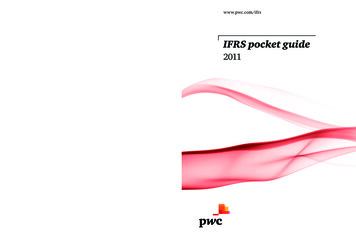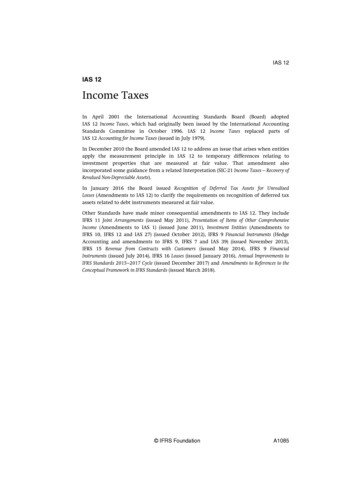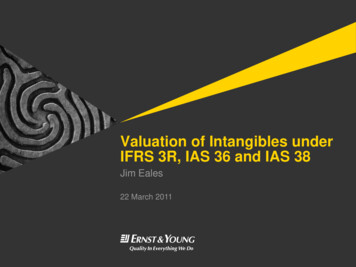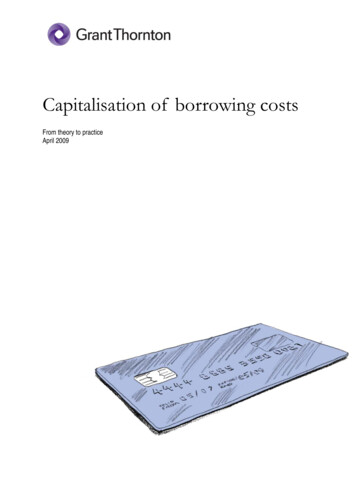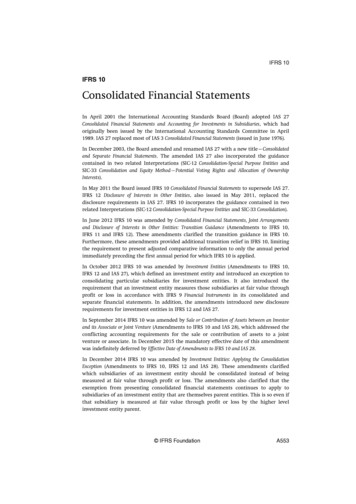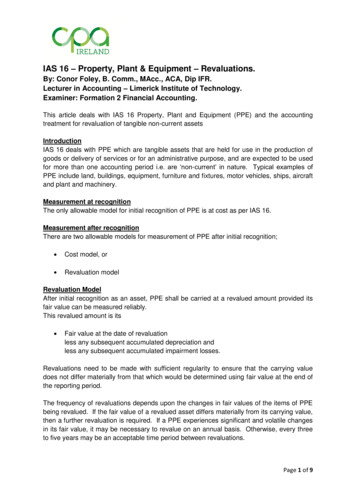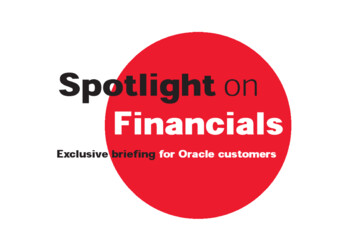
Transcription
The Impact of IAS and SarbanesOxley on UK Organisations
Michelle MadenERP and Supply Chain Solutions LeaderOracle CorporationMichael CoyleSenior ManagerPricewaterhouseCoopers
Agenday UK Governancey International Accounting Standardsy Sarbanes-Oxley Act
Corporate Governance andCompliancey Recent financial scandals have placed the entireperformance of all companies under greater scrutinythan has been known for long timey In short too many many companies have suffered toomany surprisesy Confidence in management’s ability to manage is atan all time lowy RESULT: More Regulation!
Strong Responses areevolving to drive GovernanceCorporate GovernanceBusiness Systems Accounting Boardsplacing new demands More Disclosure Common Rules Transparency Faster ReportingThe Board Code of Governancedriven by regulatorycommittees Board Composition Role of Non-ExecDirectors Compensation EthicsExecutive Impact PersonalResponsibility onCEO/CFO Accuracy Controls
Recent Legal and RegulatoryResponse: UKy July 2003 The Revised Combined Code onCorporate Governance was issued (followingrecommendations contained in the Higgs Reportand the Smith Report on audit committeespublished in January 2003)y July 2003 FSA will now exercise powers to arrestsuspectsy July 2003 DTI companies will have a choice of IFRSor UK GAAP.
The Combined Code onCorporate GovernanceJuly 2003
Increased focus onIndependence testsfor NEDsRole of theAudit CommitteeTransparency ofprocedures forappointmentsTime availabilityof NEDSPerformanceevaluationReview ofwhistleblowingarrangements
Disclosure RequirementsIndependence testsfor NEDsTransparency ofprocedures forappointmentsPerformanceevaluationRole of theAudit CommitteeTime availabilityof NEDSReview ofwhistleblowingarrangements
What does Good Governancereally mean?y Based on calculations on share price performancebetween May 1998 and May 2003, the 15 companieswho achieved above average marks on thegovernance study generated significantly superiorreturns compared to the below average companies.y On average, the above average companies achieveda share price return of over 36% over 5 years, whilethe below average companies achieved just over23%.y Source: Governance Metrics International
Annual Total Returns vsGovernance Ratings1-, 3-, 5- and 10-Year Avg. Annual Total Returns vs.Avg.TotalReturnTop- and Bottom-10% Companies by Overall r.10-Yr.-5%-10%-15%Bottom 10% CompaniesTop 10% Companies
Annual Returns vs DirectorIndependenceAvg.TotalReturn1-, 3-, 5-Year Avg. Annual Total Returns vs.Director -Yr.5-Yr.3-Yr.5-Yr.1-Yr.3-Yr.-4%-6%-8%Not Disclosed0-49.9% Independent50-100% Independent
InternationalAccounting StandardsAttracting investment throughtransparency
What is IAS About?y A full new set of financial standardsy Major differences with local standardsy Will become the a legal requirement for all EUlisted companies (and subsidiaries) toproduce consolidated accounts to IAS by2005 (2003 in Greece)y More global: also affecting APAC (Australia),Africa and US are moving towards it
What about local standards?y IAS can be used at present for Austria, Belgium,Finland, Germanyy IAS must be used in 2003: Greecey IAS can be used should existing legislation beenacted in full: Francey Legislation to allow IAS is under development:Luxembourg, Netherlandsy IAS are expected to be introduced as nationalstandards in the period to 2005: Denmark, Ireland,Sweden
However y IAS cannot be used and there are no plans forit to replace national standards: Italy,Portugal, Spain
What about the UK?y On 17 July 2003, the DTI announced that allUK companies are to be permitted to use IASfrom 2005.
What are the deadlines?1 Jan 2003Opening IFRSbalance sheet for SEC registrants Any other entityrequiring three yearsof income statements Not published1 Jan 2004Opening IFRSbalance sheet (dateof transition) for Most companies Recognise andmeasure all itemsusing IFRS Not published31 Dec 2005June2005 InterimIFRSreportingFirst IFRSannual reportingdate Select policies Use standardsin force at thisdate First IFRSfinancialstatements
What’s the impact? Telefonica - 2001 results 2.11 billion euro profit under Spanish rules 7.18 billion euro loss under US GAAP France Telecom – 2001 results––5.2 billion euros operating income under Frenchrules8.0 billion euro operating loss under US GAAP
More Examplesy Property and construction company–profit up 8%y Financial Services Company–profit down by 35%y Safety and Security service co–profit down to zero, net assets tripledy Software provider Co–profits doubled, net assets up 22%y Utility Co–profit down by 9%, net debts up 55%
Impact of IASIAS ImperativeImpact on BusinessesNew standardisedaccounting rules need tobe adoptedy Changes in policies, processes and system setupsto complyy Reported results would possibly change due tonew accounting treatments leading to change inshareholder perspectives of the businessNew reports need to bemade publicy Greater transparency into internal operationsincluding all subsidiariesy Will drive management direction to converge withexternal reporting albeit with competitiveimplicationsBooks may need to bey Labour intensive and error-prone consolidationmanaged simultaneouslynightmaresunder multiple accounting y Compliance to multiple rule-sets would impactstandardsboth executive decision making and businesssystems
What do Customers need to do now?y Establish a plan of Action:– Identify and understand differences IAS vs Local– Revise policies and procedures– Examine and critique your processes for IAScompliance– Train Staff– Take advice from their auditors– Align internal and external reporting– Assess adequacy of systems/change or re-configure– Control and monitor risks
Reporting Impact: IASMigrate and Unify CorporateReporting and Morey New Valuation Approachesy Consistency of Data fromAllLocations World Wide¾Inventory¾Financial Instruments¾Fixed Assets¾Employee Benefitsy Subsidiary Reportingy Segment Reporting25
Major Changes and ConsiderationSegment ReportingFor each Segment, report:PrimarySecondaryRevenue (External / Inter Seg.)99Operating Result9Assets & Liabilities at BS value99Assets & Liabilities at Cost99Depreciation & Amortization9Non Cash Expenses9Equity & JV Investments9Inter segment Pricing Basis99y System needs to becapable of analysing notjust Income and Expensebut Balance Sheet itemsy Substantial analysis will berequired if not dealt with inthe underlying systemsy Flexibility required in rollingup balances in a variety ofways
Major Changes and ConsiderationFixed Assetsy Could result in different asset“lives” in local and IAS book:––y Valuation methods after initialpurchase:––––Depreciable lifeDepreciable basisRevaluationCapitalizationStandard: cost lessy System will need to allow for theaccumulated depreciation anddifferent treatmentimpairmenty Reconciliation required ofAllowed: revaluation methodmovements from the beginning ofat fair value. Must be appliedthe period including impairmentto all assets of a same class.adjustmentsResult must be applied to prior y Difficult to achieve throughopposite reserves first, then tospreadsheets or consolidationP&L.systems
Major Changes and ConsiderationInventoryy Potentially the need todeal with 2 types ofcostingy FIFO or weighted average– IASallowed by IAS– Local Tax and GAAPy Accounting treatment ofreversal of write-downs in a y Very difficult to handle bylater period is credited tospreadsheet orincome by reducing thatconsolidation systemperiod’s cost of goods sold.aloneMust be reported at yearend
How Business Systems Simplify IASChallenges?y Visibility–Access to accurate, relevant and real-time informationacross the organizationy Control–Centralise and secure policies, processes, andproceduresy Efficiency–Consolidate and reconcile data quickly
Want to find out more?y Please contact your Oracle representative orcontact me directly:y Michelle.Maden@oracle.comy 0118 924 6614
Sarbanes-Oxley ActA Response to the Deteriorationin Public Confidence
Sarbanes Oxley ActFocus: Quality & Reliability of FinancialInformationWho Needs to Comply?y All Companies Issuing Securities in the United StatesWhat are the Driving Tenets?yyyyyyCorporate Responsibility for Quality of StatementsAuditor Independence from Corporate ManagementPublic Company Accounting Oversight BoardIndependence of Audit FirmsEnhanced Fiscal DisclosureObjectivity and Independence of Securities Analystsy SEC Resource, Enforcement and PenaltyEnhancementSenate Report 107-205, Public Company Accounting Reform andInvestor Protection Act of 2002, named the “Sarbanes-Oxley Act of 2002”
Sarbanes Oxley ActImpact on IT & Managementy Section 103: Your auditor must (and therefore, you should) maintain allaudit-related records, including electronic ones, for seven years.y Section 201: Firms that audit your company’s books can no longerprovide you with IT-related services.y Section 301: You must provide systems or procedures that let whistleblowers communicate confidentially with company’s audit committee.y Section 302: Your CEO and CFO must sign statements verifying thecompleteness and accuracy of financials reports.y Section 404: CEO’s, CFO’s and outside auditors must attest to theeffectiveness of internal controls for financial reportingy Section 409: Companies must report material changes in their financialconditions “on a rapid and current basis.” The act calls it “real-timedisclosure” but doesn’t define what that means.Computerworld, April 14, 2003
And .the big oney Sec 906 Corporate Responsibly for Financial Reports Failure of corporate officers to certify financial reportsy “Whoever wilfully certifies any statement .knowing thatthe periodic report accompanying the statement does notcomport with all the requirements shall be fined not morethan 5,000,000 , or imprisoned not more than 20 years, orboth.”
What is an Internal Control?Providing Reasonable Assurance of:y Effectiveness and Efficiency of Operationsy Reliability of Financial Reportingy Compliance with Laws and Regulationsor else Visibility, Control, & Efficiency
How are Your Internal Controls?y Do you have the necessary checks and balancesin your processes?y Are your processes transparent?y Are your processes well documented?y Where are your exposures?y How much will it cost for your external auditors toattest to your controls?Visibility, Control, & Efficiency
To Document, Test, & Certify InternalControlsInternal and External Auditors will Need:Workflow Management ToolsDocument Management ToolsSystem Configuration ToolsSurvey ToolsProcedure Documentation ToolsProcess Control LimitsSampling & Statistical ToolsProject Management ToolsVisibility, Control, & Efficiency
New ProductNavigating the Way:Internal Controls ManagerOracle Internal Controls Manager is acomprehensivetool for executives, controllers, internal auditdepartments, and public accounting firms to use todocument and test internal controls and monitorongoing compliance.
To Document, Test, & Certify InternalControlsOracle is Introducing:Oracle Internal Controls ManagerWorkflow Management ToolsDocument Management ToolsSystem Configuration ToolsSurvey ToolsProcedure Documentation ToolsProcess Control LimitsSampling & Statistical ToolsProject Management ToolsWorkflowFilesiSetupiSurveyTutorPerformance MgmtAudit Manager Repts.Project Collaboration
Oracle Internal Controls ManagerSolutionyyyyyyyyExpose Internal Audits to Sarbanes Oxley CertifiersHost & integrate Risk and Issues Library (COSO)Compare Internal Policies to External GuidelinesTurn Internal Policies into System ProcessesCompare Actual Practices to Internal PoliciesAssociate processes, risks, controls, locationsHighlight Application Control PointsValidate Financial Values––from the consolidated level to the transactional level at every subsidiaryVisibility, Control, & Efficiency
Oracle Internal Controls ManagerBusiness FlowInternal Controls ManagerBusiness eStructureIdentify and analyze allthe business processesthat are specific to thatparticular entityEstablish an organizationstructure that allowssegregation of duties andalerts management ofpossible ent all testingprocedures and theresults of the nductConductAssessmentsAssessmentsScopeScope AuditAuditProjectsProjectsTestTest ranceAssuranceReportReportSpecific audit projects canbe undertaken, either asa scheduled activity or asthe result of an trigger eventConduct a survey ofmanagement on theiropinion of the adequacyof internal controlsIdentify the nature of theaudit project, the scopeof testing and resourcesrequiredTest whether internalcontrols are operatingas designedBased o results of auditprojects, issue assurancereportEstablishEstablishRiskRisk &&ControlsControls LibraryLibraryCreate a library of allthe recurring risks thatcan be associated toeach business processwithin the entityEnterprise RolesCFOCEOLegal CounselInternalAuditorControllerIndependent ConsultantTutor, Financials, Internal Controls ManagerRecommendRecommendChangesChangesPropose new internalcontrols or modify controlin place to mitigate risk
Managing the Risk andControl Library
Risk Library: Deconstructing Processes
Risk Library: Process Risk Control
Risk Library: Controls & their properties
ConductingAssessments
Risk Assessment Questionnaire
Web Based Surveys
Assessment and Evaluation
Testing Controls
Testing Controls
Assurance Reporting
Assurance Reporting
Assurance Reporting
Assurance Reporting
Oracle Internal Controls ManagerBenefitsy More Efficient Internal Control Testing–Exposing the native controls of the applicationsin an auditor’s contexty Higher Certainty in Your Risk Assessment–Providing verification mechanisms as part of theapplications themselvesy Lower External Audit Verification Costs–Allowing external audit independent verificationof the same controlsVisibility, Control, & Efficiency
What Analysts and PartnersAre Saying "Businesses are scrambling to define the new requirementsfor compliance and governance, and there is a need -- nowmore than ever -- for companies to look to technology toassist in their compliance efforts."Lee Geishecker, research vice president, Gartner, Inc."When combined with third party assistance relating tosystems processes and controls, Oracle Internal ControlsManager provides companies a framework for SarbanesOxley compliance, and helps monitor audit and controlactivities on an ongoing basis."Jim Barrett, partner, PricewaterhouseCoopers Security & Privacy Practice.
What Our Customers AreSaying “Oracle's approach to business systems involvingconsolidation of data and shared service centersassists us in meeting our corporate governance goals”-- Phil Chronican, Chief Financial Officer, Westpac Banking Corporation“In a highly regulated sector such as reinsurance, a robust corporateregime with effective financial system controls was a clear priority.The goal was to increase our control of finances and to speed ourprocesses Oracle is playing an important role in that process.”-- Liz Catchpole, Chief Financial Officer, SwissRe Life and Health Business Group“With Oracle in place, our management now has a much better viewof the company. We only need to enter information once and canthen easily monitor and keep track of everything we do.”-- Roberto Albert, Treasurer, Duferco
yExpose Internal Audits to Sarbanes Oxley Certifiers yHost & integrate Risk and Issues Library (COSO) yCompare Internal Policies to External Guidelines yTurn Internal Policies into System Processes yCompare Actual Practices to Internal Policies yAssociate processes, risks, controls, locations yHighlight Application Control Points


